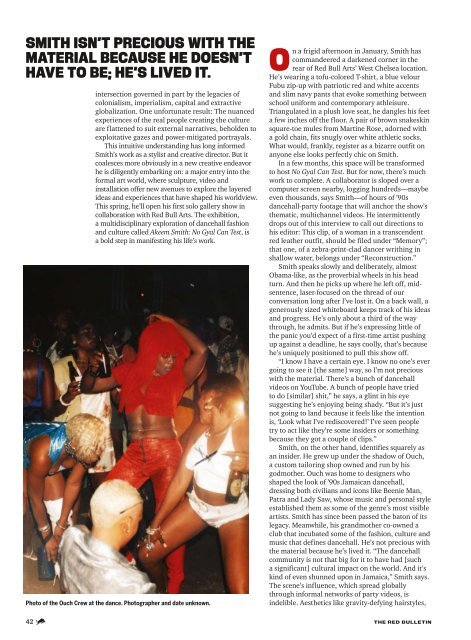Create successful ePaper yourself
Turn your PDF publications into a flip-book with our unique Google optimized e-Paper software.
SMITH ISN’T PRECIO<strong>US</strong> WITH THE<br />
MATERIAL BECA<strong>US</strong>E HE DOESN’T<br />
HAVE TO BE; HE’S LIVED IT.<br />
intersection governed in part by the legacies of<br />
colonialism, imperialism, capital and extractive<br />
globalization. One unfortunate result: <strong>The</strong> nuanced<br />
experiences of the real people creating the culture<br />
are flattened to suit external narratives, beholden to<br />
exploitative gazes and power-mitigated portrayals.<br />
This intuitive understanding has long informed<br />
Smith’s work as a stylist and creative director. But it<br />
coalesces more obviously in a new creative endeavor<br />
he is diligently embarking on: a major entry into the<br />
formal art world, where sculpture, video and<br />
installation offer new avenues to explore the layered<br />
ideas and experiences that have shaped his worldview.<br />
This spring, he’ll open his first solo gallery show in<br />
collaboration with <strong>Red</strong> Bull Arts. <strong>The</strong> exhibition,<br />
a multidisciplinary exploration of dancehall fashion<br />
and culture called Akeem Smith: No Gyal Can Test, is<br />
a bold step in manifesting his life’s work.<br />
Photo of the Ouch Crew at the dance. Photographer and date unknown.<br />
On a frigid afternoon in January, Smith has<br />
commandeered a darkened corner in the<br />
rear of <strong>Red</strong> Bull Arts’ West Chelsea location.<br />
He’s wearing a tofu-colored T-shirt, a blue velour<br />
Fubu zip-up with patriotic red and white accents<br />
and slim navy pants that evoke something between<br />
school uniform and contemporary athleisure.<br />
Triangulated in a plush love seat, he dangles his feet<br />
a few inches off the floor. A pair of brown snakeskin<br />
square-toe mules from Martine Rose, adorned with<br />
a gold chain, fits snugly over white athletic socks.<br />
What would, frankly, register as a bizarre outfit on<br />
anyone else looks perfectly chic on Smith.<br />
In a few months, this space will be transformed<br />
to host No Gyal Can Test. But for now, there’s much<br />
work to complete. A collaborator is sloped over a<br />
computer screen nearby, logging hundreds—maybe<br />
even thousands, says Smith—of hours of ’90s<br />
dancehall-party footage that will anchor the show’s<br />
thematic, multichannel videos. He intermittently<br />
drops out of this interview to call out directions to<br />
his editor: This clip, of a woman in a transcendent<br />
red leather outfit, should be filed under “Memory”;<br />
that one, of a zebra-print-clad dancer writhing in<br />
shallow water, belongs under “Reconstruction.”<br />
Smith speaks slowly and deliberately, almost<br />
Obama-like, as the proverbial wheels in his head<br />
turn. And then he picks up where he left off, midsentence,<br />
laser-focused on the thread of our<br />
conversation long after I’ve lost it. On a back wall, a<br />
generously sized whiteboard keeps track of his ideas<br />
and progress. He’s only about a third of the way<br />
through, he admits. But if he’s expressing little of<br />
the panic you’d expect of a first-time artist pushing<br />
up against a deadline, he says coolly, that’s because<br />
he’s uniquely positioned to pull this show off.<br />
“I know I have a certain eye. I know no one’s ever<br />
going to see it [the same] way, so I’m not precious<br />
with the material. <strong>The</strong>re’s a bunch of dancehall<br />
videos on YouTube. A bunch of people have tried<br />
to do [similar] shit,” he says, a glint in his eye<br />
suggesting he’s enjoying being shady. “But it’s just<br />
not going to land because it feels like the intention<br />
is, ‘Look what I’ve rediscovered!’ I’ve seen people<br />
try to act like they’re some insiders or something<br />
because they got a couple of clips.”<br />
Smith, on the other hand, identifies squarely as<br />
an insider. He grew up under the shadow of Ouch,<br />
a custom tailoring shop owned and run by his<br />
godmother. Ouch was home to designers who<br />
shaped the look of ’90s Jamaican dancehall,<br />
dressing both civilians and icons like Beenie Man,<br />
Patra and Lady Saw, whose music and personal style<br />
established them as some of the genre’s most visible<br />
artists. Smith has since been passed the baton of its<br />
legacy. Meanwhile, his grandmother co-owned a<br />
club that incubated some of the fashion, culture and<br />
music that defines dancehall. He’s not precious with<br />
the material because he’s lived it. “<strong>The</strong> dancehall<br />
community is not that big for it to have had [such<br />
a significant] cultural impact on the world. And it’s<br />
kind of even shunned upon in Jamaica,” Smith says.<br />
<strong>The</strong> scene’s influence, which spread globally<br />
through informal networks of party videos, is<br />
indelible. Aesthetics like gravity-defying hairstyles,<br />
42 THE RED BULLETIN

















